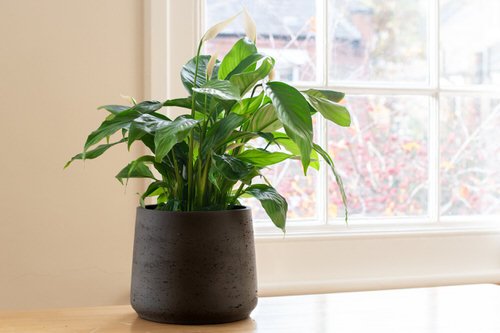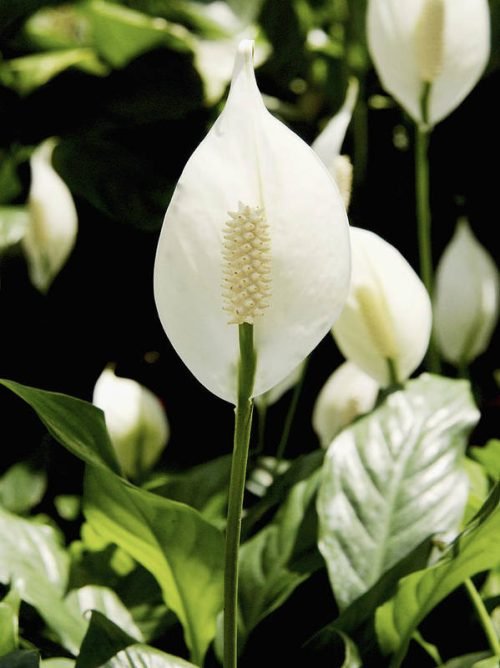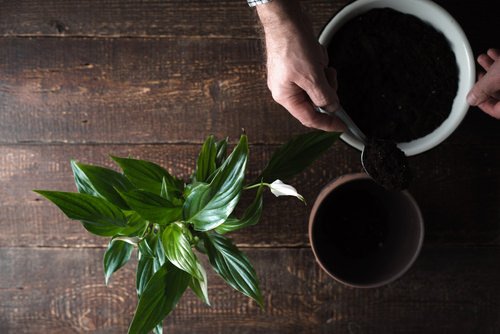Learn How to Get Peace Lilies to Bloom and lighten up your indoors with its subtle touch of elegance, beauty, and serenity!

If you are an ardent fan of white flowers (bracts), peace lilies must be on your bucket list. Whereas the plant is hardy indoors and requires little care to thrive, the flowering grabs much of your attention with uncertain results. So we’ve got this detailed article to help you on How to Get Peace Lilies to Bloom!
Here are the most common peace lily growing problems and how to fix them
How Do Peace Lily Flowers Look Like?
Peace lilies grow tiny flowers on a spike guarded by a large white bract — often mistaken as the flower. The blooms are not very fancy and look like an extension of the stalk with just the pollens at the end, but it’s the white flag-like bract that makes this houseplant special.
The plant blooms naturally in spring and summer. In warm climates, they can flower throughout the year but especially from the start of the winters.
What Stops Your Peace Lilies to Bloom?

Appropriate sunlight is the crucial point most gardeners miss out on. Your peace lilies need warmer temperatures of 60-86 degrees Fahrenheit (15-30 C) to produce perfect bracts. Higher temperatures will turn the leaves yellow, while cooler will stunt their growth.
Another common mistake is overwatering. The plant loves moist but well-draining soil. The trick is to maintain moisture without allowing the water to settle near the roots, which causes root rot. Keep feeling the top inch of soil using your finger and water accordingly.
How to Get Peace Lilies to Bloom?

Peace lilies produce blooms that last for more than a month under certain conditions that adhere to their native place — the tropical rainforests of Colombia and Venezuela!
1. Keep it Root Bound
Keeping the plant slightly root bound will promote blooming as it will then direct its energy into growing white bracts rather than spreading its roots.
2. Use Gibberellic Acid
According to Florida University Extension, Gibberellic Acid, a naturally occurring plant hormone extracted from fungi, can promote flowering in peace lilies and also helps to produce good-quality blooms in other tropical plants.
Use the acid in a foliar spray in 125, 250, or 375 ppm for best results. You can get it from a garden center or online and follow all label directions.
Beware: Plants are extremely sensitive to Gibberellic Acid, and its overuse can cause them to wilt and die.
3. Get a Mature Plant
Young peace lily plants will not flower. If you want consistent flowers, it will be a good idea to get a 1 or 2 years old specimen.
4. Grow the Right Variety
Hybrid cultivars of this plant are the ones to go for if you want more flowers. ‘Petite,’ Connie,’ ‘Mini,’ ‘Tys Pride,’ ‘Little Angel,’ and ‘Viscount’ are some of the best ones you can grow that are popular for their blooms.
5. Give it the Right Amount of Light
Place your peace lily at a place that receives bright indirect light. East-facing windows provide the perfect blend of light and shade while fulfilling the feng shui principles of well-being. This indirect light should be that enough that you can read something in it.
Bright and diffused light will give your peace lilies the energy to photosynthesize and produce more blooms.
6. Expose the Plant to a Right Temperature
According to a report by the University of Florida, Institute of Food and Agricultural Sciences, plants that undergo a chill of 12 C (54 F) can flower 3–4 weeks earlier than those not chilled.
Do not let the temperature go below 12 C (54 F) and avoid exposing the plant to temperatures higher than 86 F or 30 C for best blooms.
7. Keep Photoperiod / Photoperiodism in Mind
A report by the University of Florida states that plants that are not in flower in the late summer or fall, do not initiate flower buds during June through August under the long day/short night photoperiod.
Photoperiodism is the response to changes in day length that enables plants to adapt to seasonal changes in their environment, making them grow and flower better.
8. Avoid Using Chlorine in the Water
Peace lily dislikes the water contaminants such as fluoride and chlorine as they can turn the foliage brown. Use RO or rain water for best growth.
9. Use the Right Fertlizer and Avoid Overfeeding
Use a water-soluble houseplant fertilizer in a 20-20-20 ratio diluted to half its strength, once every 3-5 weeks. Keep an eye on the flower’s health. A slightly green hue indicates overfertilization, which needs to be cut down immediately.
10. Make Sure it Gets the Correct Humidity
Peace lilies need high humidity to produce fuller leaves and blooms. Mist the plant with lukewarm water or turn on a humidifier around it. Placing the pot in a saucer filled with pebbles and halfway water also does the job.
After Care Tips

After you are blessed with the peace lily flower, keep an eye on certain things that’ll ensure healthier plant growth:
- Wipe leaves with a damp cotton cloth every 1-2 weeks to keep the harmful pests at bay.
- Snip away dead flowers to promote healthy growth and a cleaner look.
Watch this video for more information
